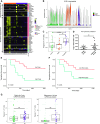Single-Cell Profiling Reveals Immune Aberrations in Progressive Idiopathic Pulmonary Fibrosis
- PMID: 38717443
- PMCID: PMC11351796
- DOI: 10.1164/rccm.202306-0979OC
Single-Cell Profiling Reveals Immune Aberrations in Progressive Idiopathic Pulmonary Fibrosis
Abstract
Rationale: Changes in peripheral blood cell populations have been observed, but not detailed, at single-cell resolution in idiopathic pulmonary fibrosis (IPF). Objectives: We sought to provide an atlas of the changes in the peripheral immune system in stable and progressive IPF. Methods: Peripheral blood mononuclear cells (PBMCs) from patients with IPF and control subjects were profiled using 10× chromium 5' single-cell RNA sequencing. Flow cytometry was used for validation. Protein concentrations of regulatory T cells (Tregs) and monocyte chemoattractants were measured in plasma and lung homogenates from patients with IPF and control subjects. Measurements and Main Results: Thirty-eight PBMC samples from 25 patients with IPF and 13 matched control subjects yielded 149,564 cells that segregated into 23 subpopulations. Classical monocytes were increased in patients with progressive and stable IPF compared with control subjects (32.1%, 25.2%, and 17.9%, respectively; P < 0.05). Total lymphocytes were decreased in patients with IPF versus control subjects and in progressive versus stable IPF (52.6% vs. 62.6%, P = 0.035). Tregs were increased in progressive versus stable IPF (1.8% vs. 1.1% of all PBMCs, P = 0.007), although not different than controls, and may be associated with decreased survival (P = 0.009 in Kaplan-Meier analysis; and P = 0.069 after adjusting for age, sex, and baseline FVC). Flow cytometry analysis confirmed this finding in an independent cohort of patients with IPF. The fraction of Tregs out of all T cells was also increased in two cohorts of lung single-cell RNA sequencing. CCL22 and CCL18, ligands for CCR4 and CCR8 Treg chemotaxis receptors, were increased in IPF. Conclusions: The single-cell atlas of the peripheral immune system in IPF reveals an outcome-predictive increase in classical monocytes and Tregs, as well as evidence for a lung-blood immune recruitment axis involving CCL7 (for classical monocytes) and CCL18/CCL22 (for Tregs).
Keywords: IPF; immune system; monocytes; regulatory T cells; single-cell RNA sequencing.
Figures






Update of
-
Single-cell profiling reveals immune aberrations in progressive idiopathic pulmonary fibrosis.medRxiv [Preprint]. 2023 Apr 29:2023.04.29.23289296. doi: 10.1101/2023.04.29.23289296. medRxiv. 2023. Update in: Am J Respir Crit Care Med. 2024 Aug 15;210(4):484-496. doi: 10.1164/rccm.202306-0979OC. PMID: 37163015 Free PMC article. Updated. Preprint.
Comment in
-
Using a Single-Cell Atlas of Peripheral Blood Mononuclear Cells to Understand Disease Trajectories in Idiopathic Pulmonary Fibrosis.Am J Respir Crit Care Med. 2024 Aug 15;210(4):385-387. doi: 10.1164/rccm.202406-1164ED. Am J Respir Crit Care Med. 2024. PMID: 39012242 Free PMC article. No abstract available.
References
-
- Kolahian S, Fernandez IE, Eickelberg O, Hartl D. Immune mechanisms in pulmonary fibrosis. Am J Respir Cell Mol Biol . 2016;55:309–322. - PubMed
MeSH terms
Grants and funding
- R01 HL141852/HL/NHLBI NIH HHS/United States
- R01 HL152677/HL/NHLBI NIH HHS/United States
- R01 HL127349/HL/NHLBI NIH HHS/United States
- UL1 TR001863/TR/NCATS NIH HHS/United States
- R03 HL154275/HL/NHLBI NIH HHS/United States
- Three Lakes Partners/United States
- F30 HL162459/HL/NHLBI NIH HHS/United States
- Pulmonary Fibrosis Foundation/United States
- K08 HL151970/HL/NHLBI NIH HHS/United States
- R21 HL161723/HL/NHLBI NIH HHS/United States
- R01 HL163984/HL/NHLBI NIH HHS/United States
- R01 HL153604/HL/NHLBI NIH HHS/United States
- U01 HL145567/HL/NHLBI NIH HHS/United States
LinkOut - more resources
Full Text Sources
Molecular Biology Databases

